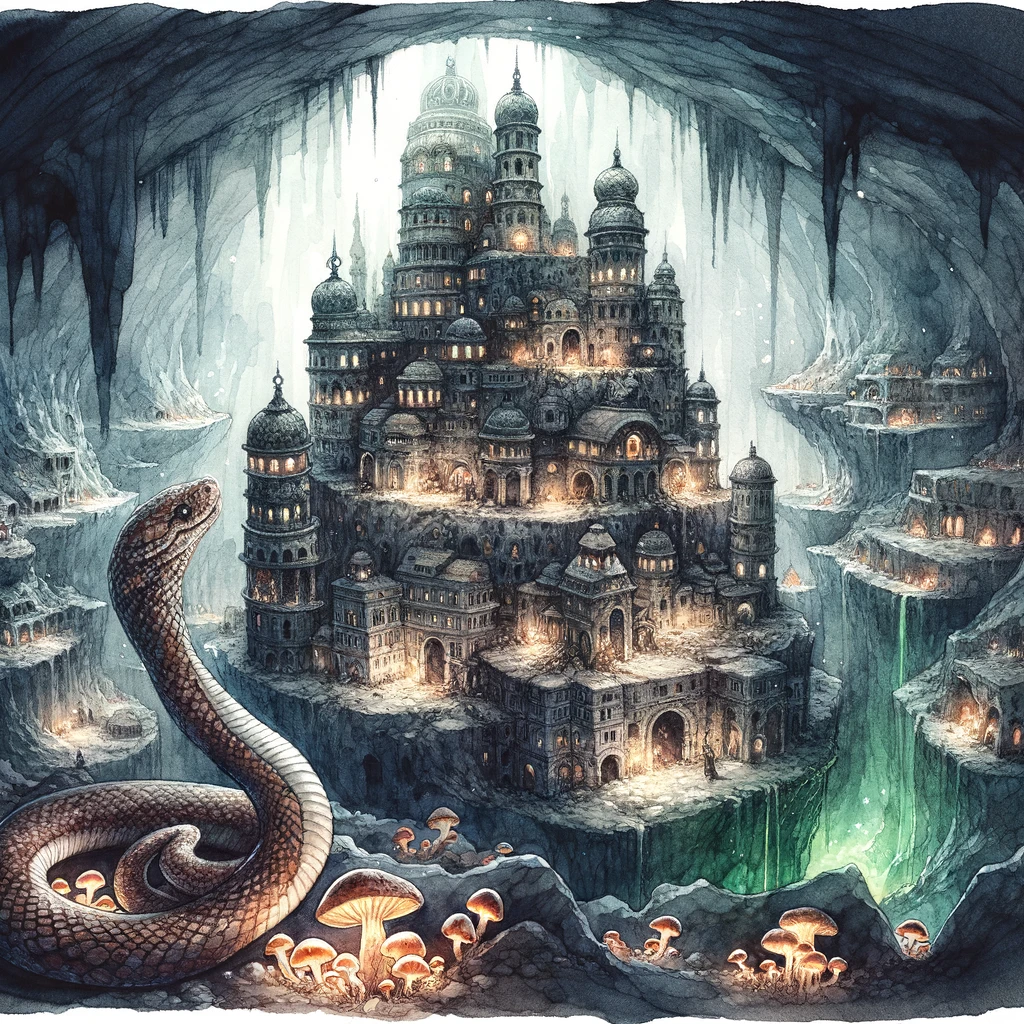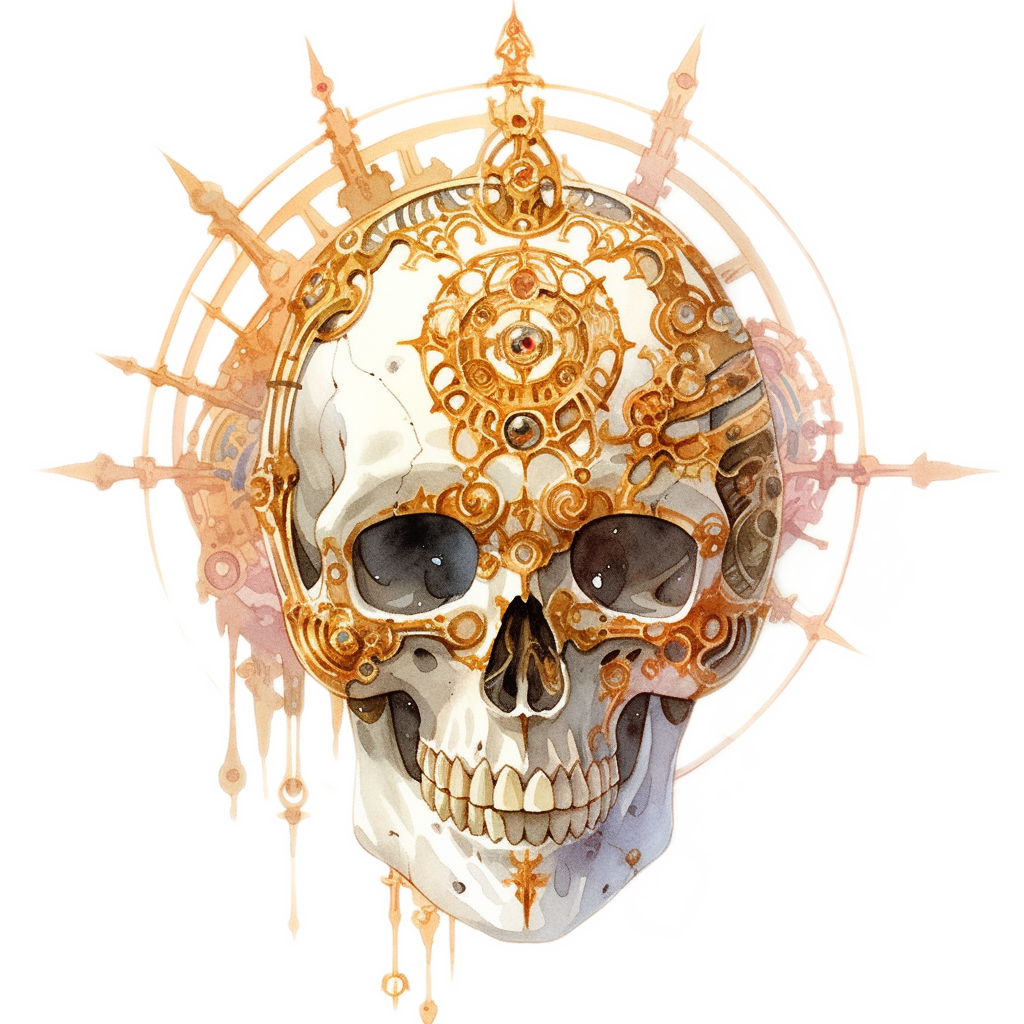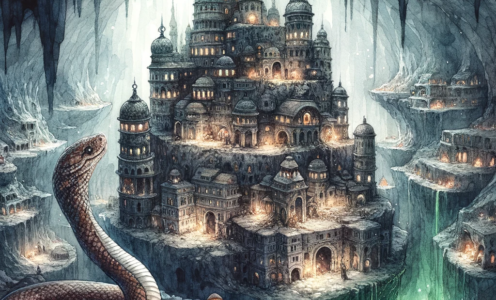Snakescale
Character: Welcome to the nexus of purest Law and most individual Chaos. Here, the laws are solid as fangbone and as flexible as a viper. The Blue God above orders his will, and it is done. We do what we will. Blue God says scour the land, and no living thing survives. Blue god says stay at home, and we are happy with full larders. Law is not as restrictive as one would think, when given the freedom of Chaos.
Ruler: Azure Skystander (prime sapphire dragon [he/him] / Athar / LN), a very old dragon (750 years) rules over this city as resident ‘god’. The populace have their theories on his true nature, but when he says jump, they do.
Snakescale is an experiment, started by Azure some five hundred cycles ago. He sought to prove that chaotic beings, controlled by a strong lawful ruler, could be an incredibly powerful fighting force. He also wanted to prove that a populace will believe any super-powerful entity they encounter is a god. He’s been right so far on both counts.
Behind the Throne: The three races living in Snakescale each have a High Priest (though Azure is incapable of granting them spells) who interprets the dragon’s commands differently. Their respective priesthoods act as high courts, quarrelling over moral and political issues while their god watches with detachment and amusement. Fortunately, Azure has very clearly stated that assassination is absolutely forbidden, but there is a great deal of subterfuge.
Description: Snakescale began as an accident, when a party of two dozen migrating ophidians happened upon the entrance to the wyrm’s huge cavern in the Outlands. Having never before encountered a dragon, the overwhelmed ophidians immediately began to worship the warm. Seeing an opportunity, Azure helped relocate the entire community of ophidians to his cavern, where they followed his decrees to the letter, thrived under his protection and grew in number.
After some generations, rumour and legend of a “snake city” attracted the attention of two other groups: the yuan-ti (well known for their chaotic evil alignment) and the couatl-kin (chaotic good beings winged feathered serpents, related to couatl in a similar way that aasimar are related to humans). Both types trickled into the new city, until there were equal quantities of each. All three races worshiped the dragon as a god. Even the yuan-ti gave up their dark god in favour of the blue dragon (and became significantly less sadistic as a result).
Now, a city of thousands of snake-folk of all kinds dwell in the ever-expanding caverns, deep below the Outlands. The strange nature of the local philosophies drags the cavern all over the Outlands, but it generally hovers a week or so from aXos. The catch is that, over the last 20 years and for the first time since its creation, the city is no longer closed. Its ophidian shock troops, yuan-ti assassins, and flying couatl-kin are widely feared, as they eliminate any threats near the city—including a number of walking castles that strayed too close. Further, the town is now open for trade, and serpent-folk merchants can be found in Sigil and near the chaotic gate-towns.
Physically, the city is built in a very large cavern which has slowly been expanded over the centuries. Many miles of galleries are hidden from view, containing all that is needed to support the city from within. There is only one known entrance, though there are hints of hidden military passages as well. On the end of town opposite the entrance, the High Temples sit, where Azure makes his will known.
Militia: About half the city is actively involved in military activities, training and defending the surface, as well as acting as a police force within the city. This gives the city a standing army of nearly four thousand creatures. Needless to say, they represent a force to be dealt with very carefully. It is fortunate that neither Azure nor the High Priests desire conquest. Most frightening, however, is the speed needed to repopulate the city. Since all three races possess methods of turning normal demi-humans into their own kind (these yuan-ti have developed this capability through arcane methods), the city can bounce back from crippled to fully populated in a matter of months, since the warriors always take prisoners, which are divided among the races and transformed.
Services: For all these intimidating factors, merchants still come to the city. The burg does have, after all, one of the most notorious bazaars in the Land: The Yuan-ti Poison Market. Because of their reptilian affinity, giant lizards are more common here than cattle, and treated lizard skins of many kinds are available. Lizardmen from Semuanya’s Bog, khaasta and bullywugs can be found here in considerable numbers, as well as rarer primes races such as hurwaeti, gatormen, cayma, and tortles. Those looking for items catering to members of these races would do well to look here (such as cayma weapons, which are virtually impossible to find elsewhere due to their size). Finally, Snakescale is the place to visit for biologists studying lizards and their kin, having the most extensive library on the subject on all the Outlands.
Local News: As usual, the couatl-kin and the yuan-ti are having a big philosophical debate. This time, it revolves around yuan-ti histachii. The couatl-kin want the yuan-ti to stop creating them and let those already created free from enslavement. The yuan-ti faction have no problem continuing, since their race reproduces more slowly than any other snake-folk in the city (since they need magic to turn prisoners into yuan-ti). The histachii give them an edge, allowing them to make “temporary” citizens to avoid being outnumbered by the ophidians and the couatl-kin. Besides, they make good slaves and bodyguards.
Another other controversy revolves around snake-folk “half-breeds.” It seems that interbreeding between the races has become possible, and half-breeds are popping up all over the place (broods are not raised by their parents, but their entire neighbourhoods). Their lack of specialisation makes them undesirable for military service, so most become merchants, ambassadors, or diplomats. They cannot join the priesthoods (which require “pure” blood, especially the yuan-ti), and are usually shunned by the majority of the city’s inhabitants. A select few have completely betrayed their former compatriots and sell their services to the forces who seek to weaken or destroy the city.
Finally, the Athar, not knowing Azure’s ancient membership, are up in arms about a fanatical city of snake-folk, and have sent a number of emissaries to try to enlighten the residents. Azure lets them try, respecting their concern but not able to reveal his faction (if he did, the snake-folk would likely follow his example and renounce him, ruining the experiment). Those evangelists who have tried their luck have had very little, being driven out by a fanatically zealous population.
Source: Belarius


